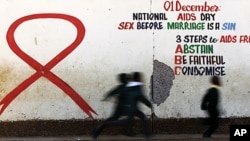The United Nations says the number of new HIV infections in sub-Saharan Africa has fallen by more than 26 percent since 1997, but the region is still the world's hardest-hit by the epidemic.
In a report released Monday, the U.N. AIDS organization said that although the rate has dropped, Sub-Saharan Africa still accounted for 70 percent of the world's new infections last year.
The region is home to two-thirds of the world's HIV-infected population, despite having 12 percent of the overall population. The report says South Africa has the world's highest number of people living with HIV, an estimated 5.6 million.
The U.N. says the number of people dying from AIDS in Africa has steadily declined since 1998 because of greater access to free antiretroviral therapy.
The report credits the decline in new HIV infections to changes in sexual behavior, increased condom use and people waiting longer before becoming sexually active.
The U.N. says that worldwide new HIV infections have fallen by 21 percent since peaking in 1997, while deaths from AIDS have fallen by the same amount since hitting a high in 2005.
The report says there has been a surge in the number of people getting access to antiretroviral therapy in low- and middle-income countries since 2009, and that treatments are having a significant impact on slowing the rate of new infections.
UN Says Number of New HIV Infections Falling in Africa








